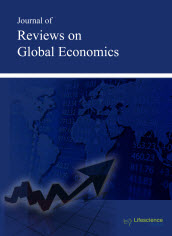jrge
Editor’s Choice : Absence of an Optimal Capital Structure in the Famous Tradeoff Theory!
|
|
Abstract: Within modern theory of capital structure and capital cost by Brusov-Filatova-Orekhova the analysis of wide known tradeoff theory has been made. It is shown that suggestion of risky debt financing (and growing credit rate near the bankruptcy) in opposite to waiting result does not lead to growing of weighted average cost of capital, WACC, which still decreases with leverage. This means the absence of minimum in the dependence of WACC on leverage as well as the absence of maximum in the dependence of company capitalization on leverage. Thus, it seems that the optimal capital structure is absent in famous tradeoff theory. The explanation to this fact has been done. Keywords: Tradeoff theory, debt financing, company capital cost, optimal capital structure, leverage, Modigliani–Miller theory, Brusov–Filatova–Orekhova theory.Download Full Article |
Editor’s Choice : Capital Flows, Financial Asset Prices and Real Financial Market Exchange Rate: A Case Study for an Emerging Market, India
|
|
Abstract: In this paper we empirically investigate the relationship between capital flows and exchange rates in India based on a new index of real effective exchange rates for the Indian Rupee. Instead of using consumer price indices we deflate exchange rates by MSCI asset price indices. The cointegration analysis indicates a long-run equilibrium relationship between real financial market exchange rate and the net outstanding equity investment in India. In the short run capital inflows are accompanied by an appreciation of real financial exchange rate of the Rupee. Keywords: Short-term Capital Movements, Foreign Exchange, International Financial Markets, India.Download Full Article |
Editor’s Choice : A Qualitatively New Effect in Corporative Finance: Abnormal Dependence of Cost of Equity of Company on Leverage
|
|
Abstract: Qualitatively new effect in corporative finance is discovered: decreasing of cost of equity ke with leverage L. This effect, which is absent in perpetuity Modigliani–Miller limit, takes place under account of finite lifetime of the company at profit tax rate, which exceeds some value T*. At some ratios between cost of debt and cost of equity the discovered effect takes place at profit tax rate, existing in western countries and Russia. This provides the practical meaning of discussed effect. Its accounting is important at modification of tax low and can change the dividend policy of the company. In paper the complete and detailed investigation of discussed effect, discovered within Brusov – Filatova – Orekhova theory (BFO theory), has been done. It has been shown, that the absence of the effect at some particular set of parameters is connected to the fact, that in these cases T* exceeds 100% (profit tax rate is situated in ”non– financial” region). Keywords: Taxes, company capital cost and capital structure, leverage, Modigliani–Miller theory, Brusov – Filatova – Orekhova theory..Download Full Article |






















